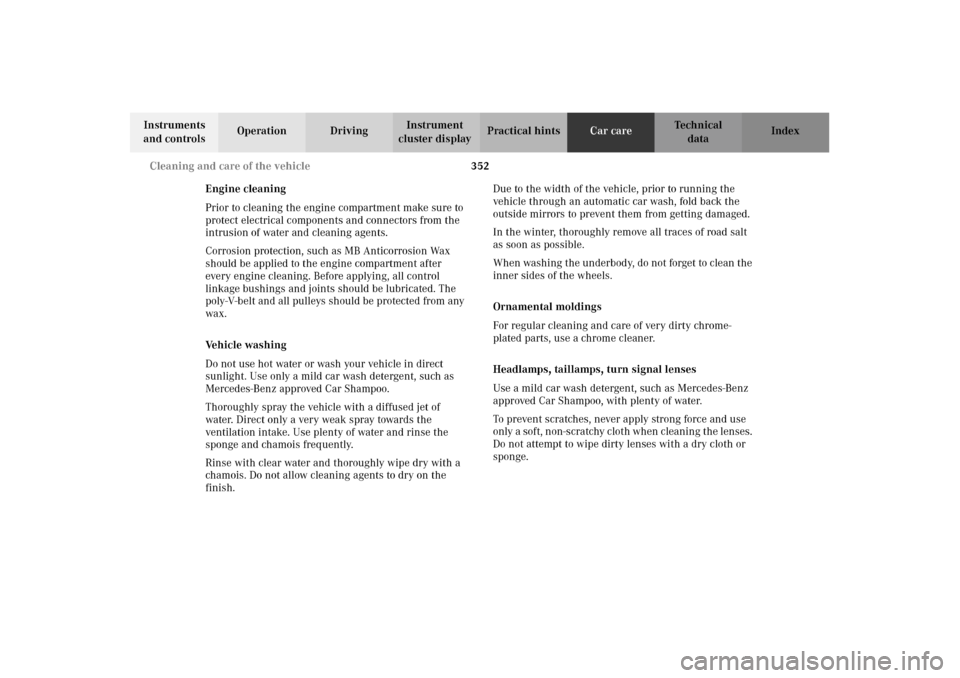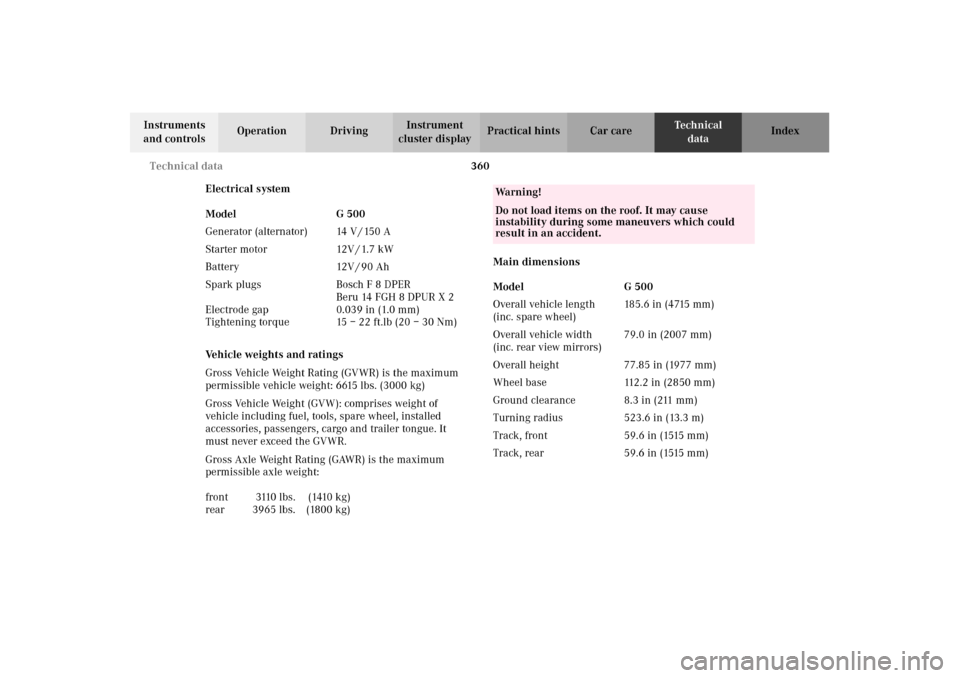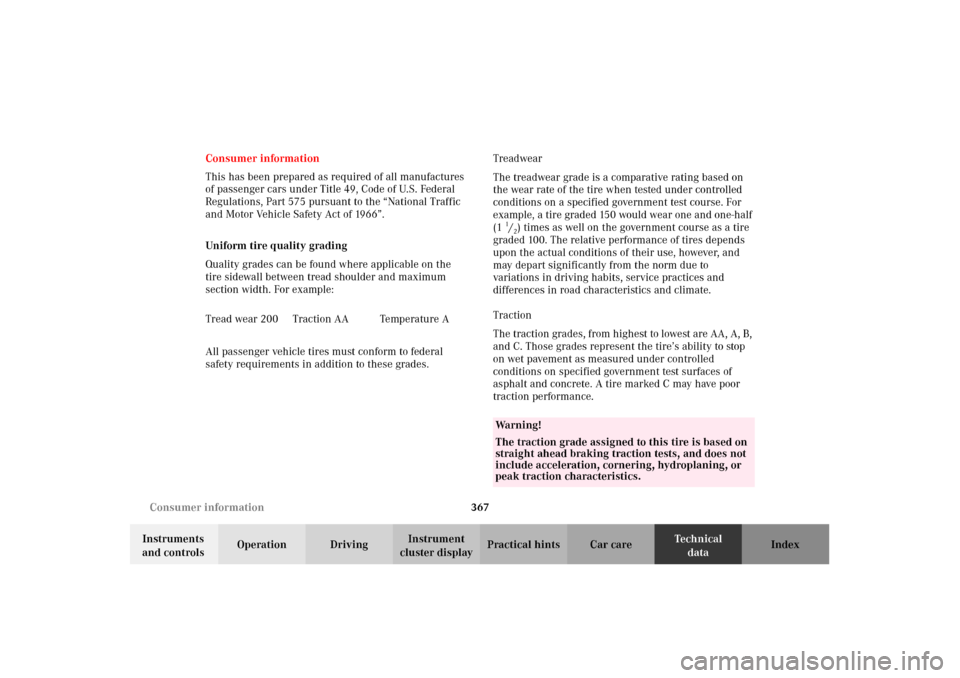Page 64 of 385

61 Restraint systems
Te ch n i c a l
data Instruments
and controlsOperationDrivingInstrument
cluster displayPractical hints Car care Index
• Never wear the shoulder belt under your arm,
against your neck or off your shoulder. In a
crash, your body would move too far forward.
That would increase the chance of head and
neck injuries. The belt would also apply too
much force to the ribs or abdomen, which
could severely injure internal organs such as
your liver or spleen.• Never wear belts over rigid or breakable
objects in or on your clothing, such as
eyeglasses, pens, keys etc., as these might
cause injuries.• Position the lap belt as low as possible on your
hips and not across the abdomen. If the belt is
positioned across your abdomen, it could cause
serious injuries in a crash.
• Each seat belt should never be used for more
than one person at a time. Do not fasten a seat
belt around a person and another person or
other objects.• Belts should not be worn twisted. In a crash,
you wouldn’t have the full width of the belt to
manage impact forces. The twisted belt against
your body could cause injuries.• Pregnant women should also use a lap-
shoulder belt. The lap belt portion should be
positioned as low as possible on the hips to
avoid any possible pressure on the abdomen.• Never place your feet on the instrument panel
or on the seat. Always keep both feet on the
floor in front of the seat.
J_G463.book Seite 61 Mittwoch, 19. September 2001 8:06 08
Page 355 of 385

352 Cleaning and care of the vehicle
Te ch n i c a l
data Instruments
and controlsOperation DrivingInstrument
cluster displayPractical hintsCar careIndex
Engine cleaning
Prior to cleaning the engine compartment make sure to
protect electrical components and connectors from the
intrusion of water and cleaning agents.
Corrosion protection, such as MB Anticorrosion Wax
should be applied to the engine compartment after
every engine cleaning. Before applying, all control
linkage bushings and joints should be lubricated. The
poly-V-belt and all pulleys should be protected from any
wax.
Vehicle washing
Do not use hot water or wash your vehicle in direct
sunlight. Use only a mild car wash detergent, such as
Mercedes-Benz approved Car Shampoo.
Thoroughly spray the vehicle with a diffused jet of
water. Direct only a very weak spray towards the
ventilation intake. Use plenty of water and rinse the
sponge and chamois frequently.
Rinse with clear water and thoroughly wipe dry with a
chamois. Do not allow cleaning agents to dry on the
finish.Due to the width of the vehicle, prior to running the
vehicle through an automatic car wash, fold back the
outside mirrors to prevent them from getting damaged.
In the winter, thoroughly remove all traces of road salt
as soon as possible.
When washing the underbody, do not forget to clean the
inner sides of the wheels.
Ornamental moldings
For regular cleaning and care of very dirty chrome-
plated parts, use a chrome cleaner.
Headlamps, taillamps, turn signal lenses
Use a mild car wash detergent, such as Mercedes-Benz
approved Car Shampoo, with plenty of water.
To prevent scratches, never apply strong force and use
only a sof t, n on -s cratchy c lot h when c lean in g t he len ses .
Do not attempt to wipe dirty lenses with a dry cloth or
sponge.
J_G463.book Seite 352 Mittwoch, 19. September 2001 8:06 08
Page 363 of 385

360
Technical \fata
Te ch n i c a l
\fata
In\btrument\b
an\f control\b Operation Driving
In\btrument
clu\bter \fi\bplay Practical hint\b Car care In\fex
Electrical \by\btem
Vehicle weight\b an\f rating\b
Gr\fss Vehicle Weight Rating (GVWR) is the maximum
\bermissible vehicle weight: 6615 lbs. (3000 kg)
Gr\fss Vehicle Weight (GVW): c\fm\brises weight \ff
vehicle including fuel, t\f\fls, s\bare wheel, installed
access\fries, \bassengers, carg\f and trailer t\fngue. It
must never exceed the GVWR.
Gr\fss Axle Weight Rating (GAWR) is the maximum
\bermissible axle weight: Main \fimen\bion\b
Mo\fel G 500
Generat\fr (alternat\fr) 14 V / 150 A
Starter m\ft\fr 12V / 1.7 kW
B
att ery 12 V /9 0 A h
S\bark \blugs
Electr\fde ga\b
Tightening t\frque B\fsch F 8 DPER
Beru 14 FGH 8 DPUR X 2
0.039 in (1.0 mm)
15–22ft.lb (20–30Nm)
fr\fnt
rear 3110 l b s .
3965 lbs. ( 1410 k g )
(1800 kg)
Wa r n i n g !Do not loa\f item\b on the roof. It may cau\be
in\btability \furing \bome maneuver\b which coul\f
re\bult in an acci\fent.
Mo\fel G 500
Overall vehicle length
(inc. s\bare wheel) 185.6 in (4715 mm)
Overall vehicle width
(inc. rear view mirr\frs) 79.0
in (2 007 m m)
O ver all h eig h t 77.85 i n ( 1 9 77 m m )
Wheel base 112.2 in (2850 mm)
Gr\fund clearance 8.3 in (211 mm)
Turning radius 523.6 in (13.3 m)
Track, fr\fnt 59.6 in (1515 mm)
Track, rear 59.6 in (1515 mm)
J_G463.book Seite 360 Mittwoch, 19. September 2001 8:06 08
Page 370 of 385

367 Consumer information
Te ch n i c a l
data Instruments
and controlsOperation DrivingInstrument
cluster displayPractical hints Car care Index Consumer information
This has been prepared as required of all manufactures
of passenger cars under Title 49, Code of U.S. Federal
Regulations, Part 575 pursuant to the “National Traffic
and Motor Vehicle Safety Act of 1966”.
Uniform tire quality grading
Quality grades can be found where applicable on the
tire sidewall between tread shoulder and maximum
section width. For example:
All passenger vehicle tires must conform to federal
safety requirements in addition to these grades.Treadwear
The treadwear grade is a comparative rating based on
the wear rate of the tire when tested under controlled
conditions on a specified government test course. For
example, a tire graded 150 would wear one and one-half
(1
1/2) times as well on the government course as a tire
graded 100. The relative performance of tires depends
upon the actual conditions of their use, however, and
may depart significantly from the norm due to
variations in driving habits, service practices and
differences in road characteristics and climate.
Traction
The traction grades, from highest to lowest are AA, A, B,
and C. Those grades represent the tire’s ability to stop
on wet pavement as measured under controlled
conditions on specified government test surfaces of
asphalt and concrete. A tire marked C may have poor
traction performance. Tread wear 200 Traction AA Temperature A
Wa r n i n g !
The traction grade assigned to this tire is based on
straight ahead braking traction tests, and does not
include acceleration, cornering, hydroplaning, or
peak traction characteristics.
J_G463.book Seite 367 Mittwoch, 19. September 2001 8:06 08